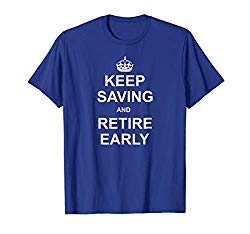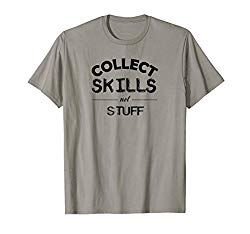Don’t Hold Your Breath Waiting For Fully Autonomous Vehicles
Artificial Intelligence and technology are rapidly changing jobs and the future of work. The job environment that will exist when you reach financial independence or retire will be very different, perhaps to your advantage. This post is the latest in my series discussing the future of jobs and how AI will impact them.
 Automation and robots are going to take all our jobs and we’ll soon be left living in an algorithmic, socialist dystopia. That’s what you might be led to believe if you rely only on shallow media hype and headline click-bait. Despite the fact that AI is actually creating more jobs than it’s taking away, this modern day meme is flawed in other ways.
Automation and robots are going to take all our jobs and we’ll soon be left living in an algorithmic, socialist dystopia. That’s what you might be led to believe if you rely only on shallow media hype and headline click-bait. Despite the fact that AI is actually creating more jobs than it’s taking away, this modern day meme is flawed in other ways.
When the future of automation is mentioned in the media, the most often cited example is that of autonomous vehicles. That’s understandable since America is obsessed with cars and companies like Google have been testing them for quite a long time now.
Google’s autonomous car spin-off, Waymo, is the undisputed leader in the race for a fully functioning self-driving car. So I was a bit surprised it didn’t make more of a stir last November when the CEO of Waymo, John Krafcik, came out and basically said autonomous cars won’t ever be able to drive in all conditions.
According to CNET, Krafcik “doesn’t think the industry will ever be able to drive at any time of year in any weather and any condition, the highest driving rating. Driving in all conditions can be difficult for humans too, he noted”.
Yes, driving is difficult for humans indeed, as witnessed by the near 40,000 deaths annually from car crashes and thousands more deaths from drivers who strike and kill pedestrians.
Uber found this out firsthand in March 2018 when one of their self-driving cars struck and killed a cyclist in Arizona. That vehicle even had a real human behind the wheel who was supposed to function as a backup if the technology failed. In the end the technology and the human failed.
Despite warnings of safety concerns from inside the company, they persisted in their trials, and now someone is tragically dead.
Uber isn’t alone. Tesla has had numerous deaths from crashes with it’s autopilot feature.
There’s a reason Uber and most every company chasing a fully self-driving car mostly test in sunny and dry environments like Arizona. The current technologies being used cannot handle bad weather.
Do you ever drive in rain? Yeah, I thought so. I work with LIDAR technology which is one of the most commonly used sensors in self-driving cars and I can attest, scientists haven’t figured out a way to stop LIDAR from becoming befuddled in rain and snow.
Right now, I wouldn’t get in a car on a highway that claims to drive itself, would you?
I value my life far more than that.
Lots Of Jobs Could Be At Stake
Let’s get back to the loss of jobs. It is true that truck driver is one of the most common jobs in America.
That map comes from a great NPR article that shows how jobs are changing over time.
So what if we do accomplish the achievement of fully autonomous trucks? What will all these truck drivers do for a living?
First off, as the Waymo CEO indicated, fully autonomous vehicles that can drive in all conditions aren’t likely coming. That point could be argued, but remember he’s only the CEO of the industry leader. Even if you’re not comfortable saying “never”, it’s highly likely they won’t be here for decades.
Recall just a few years ago when prognosticators were claiming “by 2020 we’ll have huge fleets of autonomous vehicles on the roads in operation”. I called BS then and laughed. I was right.
The reality here, as with anything, will be far more complex and nuanced.
 As fully autonomous trucks very slowly get safer over the coming decades, real humans will still be in them, as a backup. There will be a long period where we’ll still need people in the cab as a backup to prevent the technology from killing more people.
As fully autonomous trucks very slowly get safer over the coming decades, real humans will still be in them, as a backup. There will be a long period where we’ll still need people in the cab as a backup to prevent the technology from killing more people.
This will play out over many years, likely decades. Don’t hold your breath waiting for it.
As the story plays out it will be clear to everyone that banking on a career as a truck driver might not be the best idea, so people will adjust. Some will still go into that field, and some will of course still be needed.
But to pretend that this is a black and white issue, and we’ll wake up one Monday morning and see on the news that 2 million truck drivers just lost their jobs overnight to perfectly safe autonomous 18-wheelers is simplistic and silly. Reality doesn’t work like that.
The future of driving and mobility in general will change drastically over the coming decades for sure. But we will experience and affect those changes as the developers and consumers of the technology that will change it. We’re not unwilling and hapless bystanders watching from the sidelines with no ability to react and adapt.
We’ll be part of the story.
This is the second in a series of posts I plan to do about AI, automation, and their impact on the future of work. The first is here. There’s lots of angles to this subject to explore, and I hope to get great feedback from you, my readers, to open up new avenues of thought.
Your turn AF Readers – What do you think about self-driving cars and trucks and my prediction? Do you see it playing out differently? Would you get in one now and let it drive you on the highway at 65mph?












































These cars scare the crap out of me. Whey do we need them? Even if there’s a driver as a “backup”, how much attention are they going to be paying to what’s going on around them. It’s a bad idea. We’re talking about a 2 ton projectile here. In the case of an 18 wheeler, ten times that at a minimum.
I love technology and advancement. Not a fan of this one. I hope you’re right about the timing. I hope it takes decades, if not longer. We’ll all be safer, IMO.
Thanks for raising the issue. Love this series.
I agree a self-driving 18-wheeler is a terrifying thing. But you ask “why do we need them”. Well, we need to get to a place where 40,000 people aren’t dying every year, with another couple hundred thousand injured. So I agree the end-goal is a laudable one – to stop the mass-death on our roads which as I pointed out in another post is a much higher toll than our deaths in wars. If you look at commercial flying, we’ve made it super-safe through automation. The planes practically fly themselves and we haven’t had a commercial crash in the USA for 10 years. The problem is, automating planes it turns out is counterintuitively much easier than automating cars. Besides take-off and landing – which are in highly controlled areas, it’s a pretty simple thing. Driving on the other hand, requires full attention at all times in complex and dynamic situations. And we suck at it as people, thus the death toll.
If robots could help us save those 40,000 lives annually it would be one of the biggest lifesaving technologies ever devised. But the time between now and when we master it will be scary. Things will go wrong, more people will die.
The aviation field is a leader in devising safety systems. Sadly, the average driver can go to a bar, throw back more than a handful of drinks, and choose to drive, but no flight team is going to allow an intoxicated pilot to fly a plane. The medical field constantly tries to learn from aviation, since they’ve been masters at maximizing and ensuring safety. We’re continually working on improving our safety standards and processes.
There was a BBC article not too long ago about how train crashes were prevented in Japan (I think). They employed mindfulness by verbally stating each step in the process as they performed it. Focusing on the specific steps ensures all the technology is functioning properly. Even with AI, someone will need to continue checking function.
This topic pops up fairly often on the FI message boards, and many of feel our fields are pretty secure. Interesting about the truck drivers, though. I would never have guessed so many existed! No surprise about Colorado and software developers, though!
If only there was a way to invent some technology where the mode of transportation utilized a more easily navigable surface that was less effected by weather. Maybe like a thin steel beam spanning between locations that many people traveled to and from everyday. We could link a bunch of cars together for greater efficiency, and design some safety systems into how these long stretches of steel were set up and coordinated as many long links of cars navigated them.
Oooo! Another idea!
Anywhere this system intersected with normal pedestrian routes, we’d either have these long strings of cars stop and pickup/drop off people , or at least have big flashing lights to warn of the danger of crossing such a route.
I don’t know. Maybe it’s a crazy idea, and would be worse than what we’ve got now.
It just seems like there’s got to be a better way to transport the public.
You’re really on to something! You could even transport materials using this crazy contraption.
Ha, yes you could!
It’s not a crazy idea, we need more ideas like that to figure out the future of moving people. Because right now moving people is a deadly thing, even though we celebrate car culture in America, which I find fascinating and depressing.
As driving potentially gets “easier” b/c we can outsource it to tech, I wonder how many more cars and trucks will be on the road. I live in NYC, and every other car, sometimes two of three or more than that!, are ride-sharing cars. Part of this is the crumbling mass transit infrastructure. But part of this is the availability of a car is too much of a temptation to take mass transit. NYC is still a very walkable city but it’s CROWDED. When I’m in Tamarindo, Costa Rica, even on spring break, it’s not that crowded, and I end up walking more.
Very true that many studies show Uber and Lyft have made big-city traffic worse in certain places. If you ask me we should close off roads in many big cities and let people move by walking, bikes, scooters, and mass transit. But in our car-obsessed culture that opinion is worse than being for hurting kittens.
first off i can see the skill levels of drivers getting even worse than the slide of the past 30 years. i liked when it took a little something to work a clutch and manual transmission even if you’re going to automatic. have you ever had to use a choke to start a vehicle? i think we depend too much on some of the electronics already. “i don’t need to pay attention, the lane control warning will save us all from my lack of skill and attention.” “was that cardi b. on the i-tunes machine? let me not pay attention to the road and fix the playlist.” i would take my skills on a snowy road against the robot skills but they didn’t develop overnight either.
So true that technology, while trying to help, often makes us lose skills or get ‘dumber’. Take GPS and Google maps. It’s proven they’ve eroded people’s abilities to navigate, or even tell north from south. Once you let something or someone do something for you, you start losing faculties. But as I stated in reply to Fred, saving 40,000 lives a year could be one of the biggest technology wins in history if we could make self-driving cars 100% safe. So there’s that.
I would no sooner get in a “self-driving car” and let it hurtle me down the road at 65+mph than I would perform my own hemorrhoid surgery.
If our primary concern was safety we would simply move away from relying on cars for transport and lean more heavily on other methods. Hint: bikes are the answer.
“we’ll wake up one Monday morning and see on the news that 2 million truck drivers just lost their jobs overnight to perfectly safe autonomous 18-wheelers is simplistic and silly. Reality doesn’t work like that.” – Correct. There’s this thing called seeing the writing on the wall that motivates people to make changes ahead of time.
In the near-term I suspect jobs like truck driver will change but won’t disappear. I was in a meeting with a company developing a gig-economy type platform to match up available truck drivers with available deliveries. Essentially we’ll continue to get more efficient at matching up a skill/resource to when/where it’s needed.
There’s a savvy blogger out there selling an online course on how to do hemorrhoid surgery on yourself. He’s making a killing…. 😉
And as you know I’m in 100% agreement with you about bikes. I just wish other folks would get more on board. But being afraid of being killed by a careless driver is real, and I have that fear too, both in a car and on a bike.
I made the mistake of having a wisdom tooth pulled without general anesthesia in order to save some money. Of course I had a local so I didn’t feel any pain. But I felt, heard, and saw the effort another human goes through when forcibly removing part of my body. Never again.
I think we need more pilot projects or short- term examples of car-free life to show people what it could be like. Things like Ciclovia in Bogota –
I have had the honor in participating in the Bogota Ciclovia! Way way back in 1999, it was amazing and so much fun to not be worried about cars and just be able to ride!
Everyone forgets there’s an ancient technology that’s been moving goods across the country for decades and it’s nearly fully automated — trains.
A train *a mile long* can move goods in nearly any weather with only two humans on it. There’s really no reason why the humans need to be there other than regulations and safety. Most trains could be run by an AI and a live human in an air conditioned control room.
Trains are also the most *energy efficient* way to transport goods across the country. Less energy means less pollution. Trucks should really only be needed for last mile deliveries.
IMHO the rail network is a sorely forgotten treasure.
You are so correct. Freight rail is immensely more efficient than trucks. And for the last mile, we could perhaps us drones for much of it. So trains and drones could free us from trucks and vehicle deaths.
I read somewhere that it really depends on location. If you live in Las Vegas, Los Angeles, or Phoenix, you’ll probably get self driving car sooner. Maybe the self driving feature will only activate on sunny days? I guess that’s not acceptable.
One of my friends work in an image processing company and they’re working on self driving car. Why can’t they rely on image instead of LIDAR?
Yes they probably will come to sunny and rainless places first but will still have to dis-engage self-driving in certain conditions and have a human behind the wheel.
As for using imaging, there are some companies working on that but it’s far more complex and requires a lot more processing power, storage, and thus power. In addition, it has it’s own issues with glare and other things that can plague photos.
Ahh. I see. Thanks for the explanation. They’ll probably have to combine different technology to make it better.
I actually like the enhanced autopilot feature in my Tesla. It’s far from a “self driving” automobile, but it’s not intended to be self driving at all. It basically sets pace with a car in front of me and keeps the car in the middle of the lane very well.
The accidents and fatalities that occur with Teslas in enhanced autopilot are incidents where the driver was asleep or not paying attention. It’s not perfect, especially in cases where the lanes are poorly demarcated or if the lanes split and there is a center divider that suddenly pops up (as in the referenced article).
While not perfect, I think the enhanced autopilot really improves safety, especially in a traffic-congested area like Southern California where your mental energy can be drained in traffic. Enhance autopilot allows you to relax a bit and focus more on the road versus putting so much attention to driving.
That said, I agree with you. We are years away from full autonomous vehicles (that are safe) in my opinion.
I agree Doc, the problem with the “in between” time when the technology is only half there is that it’ll require humans to still be ready to take over. But when the humans are used to not doing much they’ll become complacent. That’s what happened to Uber in Arizona, the girl who was the backup was playing on her phone and the car killed the cyclist. To me even though humans suck really bad at driving, it’s best if we’re either 100% in control or not at all. The in-between state can start to erode our attention and make us even less attentive than we are now. It’s a real danger.
But overall I do want to technology to win – saving all those lives and injuries is a worthy pursuit and I’m for it. I’m just a realist.
I’m fairly optimistic about autonomous vehicles and I think they’ll go really far in the next 10 years. With the amount of capital and players in the space, I’d not be surprised if AVs begin to replace humans in cases that’re less likely to cause fatalities. For example driving on less congested highways, grocery delivery. But I may be biased because I’m a huge advocate of living car-free.
I’m pretty optimistic too, but just a realist since I know much o the technology intimately. But believe me, I want it to succeed and save lives. We just need to be smart about it.
Re: “Right now, I wouldn’t get in a car on a highway that claims to drive itself, would you?”
No way. I probably would have before I read this post though. And I wasn’t too worried about self-driving planes until they started resisting untrained pilots’ attempts to correct course.
The recent developments with the 737-Max are disturbing indeed
I have Autopilot Version 1 in my Tesla and it is far from perfect but it does well for what it was designed to do. With nice weather conditions and highway driving I feel it is on par with an above average driver. The newer versions with more cameras and more computing power take this to an even higher level.
There are things that will certainly be beyond its capabilities for the near future with weather being the main one (my car with only 1 forward facing camera also has trouble cresting hills on side roads).
But in the end I do think this will be safer than letting humans drive. Seeing people text, do makeup, talk, eat, etc while driving will cause far more injuries b/c of distracted drivers.
It will be safer than humans in the end. Sadly that’s not too high of a bar to clear, but reality is showing that it’s still hard.